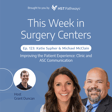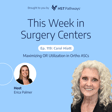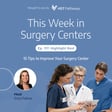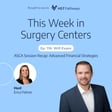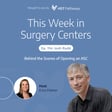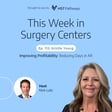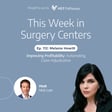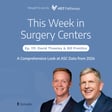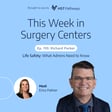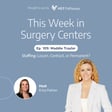Introduction to ASC Industry and Guests
00:00:01
Speaker
Welcome to This Week in Surgery Centers. If you're in the ASC industry, then you're in the right place. Every week, we'll start the episode off by sharing an interesting conversation we had with our featured guests, and then we'll close the episode by recapping the latest news impacting surgery centers. We're excited to share with you what we have, so let's get started and see what the industry's been up to.
00:00:27
Speaker
Hi, everyone. Here's what you can expect on today's episode.
Importance of Data in ASC Strategies
00:00:32
Speaker
Jeff Lawrence from Envy is here this week to talk all about data.
00:00:36
Speaker
Clean, robust, and actionable data should be at the core of your surgery center strategy if you want to continue to thrive. We'll dive into the tools and systems you can use to pull the data, and most importantly, chat through how you can use it for savings opportunities. And in our news recap, we'll cover a few nursing schools that are offering free tuition in exchange for a pledge to work post-graduation, exciting news from SCA Health,
00:01:05
Speaker
how providers are attempting to tackle healthcare for the homeless, and of course, end the new segment with a positive story about AI software that has been successfully trained to detect breast cancer. Hope everyone enjoys the episode and here's what's going on this week in Surgery Centers.
Jeff’s Role in Business Development and Healthcare Software
00:01:27
Speaker
Jeff, welcome to the show. Ah, pleasure to be here. Pleasure to be here, Nick. Appreciate it.
00:01:33
Speaker
Jeff, can you tell our listeners a little bit about your current role and some of your overall experience in the SC industry? Yeah, so I'm currently vice president of business development with Envy, and so I'm responsible for business partnerships and the sales team.
00:01:51
Speaker
Um, I've been in healthcare software for 22 years now with a kind of a small stint in between for a data cleansing delivery. So, uh, very, very focused in this small little area. Um, I've been with envy for about 14 years now.
00:02:09
Speaker
And as part of NV and kind of in that same role and with NV, we're basically a materials management system, cloud-based materials management system for the healthcare space and specifically kind of a focus in that ASE space. So the past 14 years with NV has been very focused on ASEs and clinics supply chain optimization.
00:02:35
Speaker
Fantastic. 20 years in healthcare technology is enough to know what you're talking about. I've seen a lot of interesting things. There's no doubt.
Operational Data for Cost Reduction and Efficiency
00:02:46
Speaker
Jeff, I wanted to drill in with you today and talk a little bit about the operational data categories and data elements specific to ASE operations and running facilities more efficiently and reducing costs.
00:03:01
Speaker
And so as we think about those kind of overarching data categories that ASC should be thinking about, how do you think about that at kind of the highest level? Yeah. And so I always kind of start with, you know, understanding the importance of, you know, data. And I really kind of picture I have in my mind is kind of data is the DNA of the supply chain. So it's absolutely foundational and core to kind of everything that you do from there.
00:03:26
Speaker
Um, and actually maybe a quick disclaimer as well, because like when I, when I look at a commitment to data, that's also like a commitment to technology and automation. So they're really kind of all tied together because when I look at data, it is the foundation of your software. So in order to maximize the value of your software, you have to optimize your data within those software systems.
00:03:49
Speaker
in order to get the most from your software, but then that will be driven by kind of the data that you're managing within those systems. They can practice management, think purchasing systems, like those are the ones that data that I'm referring to. Right. I think that's a good disclaimer, especially on, hey, we can't talk about data unless we talk about systems and software systems and tools. We can't really talk about software systems and tools unless we talk about
00:04:18
Speaker
business processes that those tools support. And so I think those all three are definitely interlinked. Okay, so we've got the disclaimer and then going back to the data and kind of the categories of data, what do you think are the foundational categories?
Data and Preference Cards in ASC Efficiency
00:04:34
Speaker
Yeah, so when I'm looking at data too, there's kind of multiple different systems that are kind of in play in an ASC, right? And kind of like the outcomes that we want to drive
00:04:46
Speaker
are going to be, hey, we want to make sure that we are driving accurate case costing. So the data related to driving that accurate case costing is kind of specifically what I'm looking at. So, you know, hey, you have patients, you have products, you have prices, you have, you know, kind of charge masters, you have, you know, kind of the related preference cards that are related to that. So all of that data related to those practice management systems. And then kind of that other major component is going to be kind of supply chain spend management.
00:05:16
Speaker
So kind of having that system or that database, which is that complete repository of all of the products and services that you're buying. And so then it's the related data to support that purchasing. So think of like the different products and the reorder numbers, the units measure, the pricing, all of that information that is kind of at the lowest level that will feed up to the software and the processes that need to be in place to kind of run accurately. Great.
00:05:45
Speaker
So let's take that outcome of case costing, which really kind of informs the huge piece of the P&L of an ASC, right? You've got your revenue, which is driven by cases, and you've got the cost side of it. And so let's talk about that case costing and see if we can break it down a little bit. So we have preference cards, right, which align at the facility in terms of the cases being performed
00:06:14
Speaker
and the inventory and the pieces and the products that go into delivering that case, right? How well do you think that the industry is doing preference cards today? And what's been your experience? Does everybody have those nailed? Or do you see some centers that are doing great and some centers that have opportunity? Yeah.
Challenges with Preference Cards
00:06:35
Speaker
Well said. Some that have opportunity.
00:06:38
Speaker
Um, it is, it is not a universal, uh, accurate, um, you know, kind of database, which drives, you know, accurate case costing. I've seen way too many times when people will, you know, calculate their case costs every other year. It's like once every two years of determining what their case cost is just because it's too much work. Um, and that's where I think we really kind of need to change kind of the philosophy that this really needs to be a key strategy.
00:07:04
Speaker
because you have to have accurate data, which is informing your cases, which is informing kind of what your case cost is. And I would probably say we kind of have to take one step back from there to start, because when I look at some of those different systems that are in place in an ASE, one is how you need to be purchasing. So if you initially focus on, hey, I want to make sure
00:07:25
Speaker
that all of my purchasing data, so I have like a single repository, right, for all of my purchases. So I have a single repository, so my products are accurate, my descriptions are accurate, my reorder numbers, my costing. So the products that I'm buying is accurate. Now let's make sure that that information is also feeding kind of that clinical or practice management system. So if I'm buying the right products at the right prices and I'm focused on that data,
00:07:53
Speaker
And then I use integrations and or kind of just like elbow grease and making sure that you're kind of doing it properly the first time. It's going to feed the products and the prices that are in the clinical system, the practice management system, which will then inform the cases and the products that are tied to those preference cards. So it's not just like, oh, hey, let's keep accurate preference cards.
00:08:17
Speaker
We have to take that step back, right? Let's make sure that we know all the products we're buying. We know the information. We know the price associated with those. That then needs to inform my clinical system, which feeds up into my case costing through my preference cards. Does that make sense the way I said that? It does. So the inventory has to be accurate to be accurately reflected on the preference cards. And where do you see, because that makes a lot of sense.
00:08:46
Speaker
Where do you see the breakdowns? When there's inefficiency in an ASC setting, where do you see the breakdowns? Is it on, hey, more often than not, the preference cards aren't accurate with the right inventory components and supplies? It's a bit of a snowball because as soon as the information associated with those products starts to become inaccurate, then all of a sudden it becomes less relevant for people to feel that they need to maintain
00:09:13
Speaker
the proper products on those preference cards. So it's kind of, hey, make sure you have the right data in the system and all the relevant products that you're purchasing is available. And so then when folks are building those preference cards, the data is available and relevant and accurate and complete. It makes it a lot easier for them to feel that it's relevant for maintaining the preference cards. Yeah. Great.
Partner Relationships for Product Data Accuracy
00:09:41
Speaker
How do you kind of advise customers to think about this? Or maybe if they're setting it up for the first time, you know, maybe in a de novo setting is an example. How should they think about the products that they're going to have in the data, the cost data, the other data that they want to be capturing around those products? Yeah, so I mean, this is where you really need to start leveraging some of your partners as well.
00:10:05
Speaker
Like, you know, every AC is going to have a primary distributor. They're going to have a good relation. They're going to have direct suppliers. They're going to have reps associated with that. They're going to have GPO partners, you know, that can kind of help. So it's understanding the importance of the data and working with those suppliers in order to make sure that the products that you're going to be buying, that they're ready to supply, but that is also going to be informing, like in that de novo setting, also going to be informing the data that's get, that's get loaded into the system.
00:10:32
Speaker
to start because data is always accurate at one point. It's what happens after that, right? So at the beginning, it feels a little bit easier. Hey, here's all the products I'm buying and I can get a file from my suppliers of, Hey, here's the products that I'm buying and or I need to buy. And that can inform what it is that I'm going to load into my system. Got it. So you start with the, start with the products and the suppliers of the products, feed that into your inventory system.
00:11:00
Speaker
that feeds into your preference cards, which feeds back into your practice management system as the overall kind of system of record of your revenue expenses. Is that kind of the... It's just that simple. Yeah, exactly. It's that simple. I don't know why we think this is hard. Yeah. Do customers ever get hung up in terms of that data flow across the different systems?
Efficient Data Flow Between Systems
00:11:22
Speaker
Because oftentimes, as you mentioned, sometimes inventory management system is different than practice management.
00:11:27
Speaker
system. So are there any best practices to getting that flow and that data flow to work well? Yeah. And I would say it's kind of the measure twice, cut once kind of philosophy. So as you go in and you're thinking about what is my strategy, it's thinking about and evaluating those.
00:11:47
Speaker
you know, lots of people use a purchasing system that is different than their practice management system. So when you do that, there's a lot of efficiency that's driven with that for like that best of breed purchasing system. Well, you need to ask that question up front. Hey, do you integrate with my practice management system? And if the answer is no, you're not going to have an optimized supply chain and data strategy.
00:12:12
Speaker
When the answer is yes, then it's like, okay, let me look closer at this because I need to ensure at the front end that my partners, my different systems are going to be able to talk to each other. Yeah. Makes sense. Tell me a little bit, Jeff, about the contract utilization component
Optimizing Contract Utilization
00:12:30
Speaker
of this. And when we're talking about inventory and inventory management and tying back to the contracts and the overall contract utilization optimization, how does that work?
00:12:41
Speaker
Yeah, this is a really interesting one because we think about an inventory system. We need to make sure that we have all of the products that we're buying. What we need to optimize, like one of my goals I kind of put out in beginning with data is kind of spin management as well. So when we kind of optimize and we know what products we're buying and we consolidate all that information into one system, we can then use that data to share with those partners that I was referring to kind of like your distributor,
00:13:10
Speaker
direct suppliers, you can share that information with those partners so that those partners can help you identify where there's contracting opportunities specifically for you. And the contracting opportunities is what's really going to enable you to kind of maximize your contract utilization. And that contract utilization should be able to drive your pricing down when you have data and you're able to share that with the partners so they know exactly what it is that you're buying.
00:13:38
Speaker
Great. Do you have an example of that you can share in practice of a time when a center kind of worked collaboratively with their partners? Yeah, it's probably a good idea. Let's bring an example here, an image for people's minds here. So think about you have all of your purchase history information within a system, and you run a data extract. So it's like, hey, your partners, let me share with you. And I was starting with the GPO group purchasing organization.
00:14:08
Speaker
because there's several large GPOs and they have contracts with pre-negotiated products on a lot of the products that are being purchased by ASEs. So I take my data and I send it over to my GPO partner rep and say, Hey, can you analyze that for me? And so what they would do is they're going to take this purchase history file, which is all your line level purchases. They're going to take their GPO contract file and they're going to push those together and they're going to identify for you, Hey, here's products that you are buying today.
00:14:37
Speaker
that our organization has pre-negotiated rates that are better than what you're paying, would you like to activate some of these contracts which will be able to drive your product's product price down?
Collaborating with Partners for Savings
00:14:49
Speaker
And so by doing that analysis, they're able to compare exactly what you're buying to exactly where they're savings opportunities. And some of them are easy, right? You know, I'd say it's a contract that's the exact same product that you're buying, exact same unit of measure. It's easy, yeah. If I can save money, let's activate the contract. Others of those might be more
00:15:06
Speaker
Um, you know, you, you, you might have to, um, convert. So you might have a product that's similar to something else that's on contract. Is it worth converting to save the doll? You know, the amount of money that they're able to identify. And the answer many times is no, but it's really looking at all of that. And then there's going to be an output from that analysis, which is going to be, and here are the products that I can't help you with. And that's what you take and go to your distributor or not your distributor, but your
00:15:35
Speaker
a direct supplier. And so you say, hey, my implant vendor, let me go talk to my sent these and say, hey, here are the products that if I negotiate directly with you, I'm gonna be able to drive costs down. So when you look at those two buckets, like a GPO bucket and like that direct or local contract bucket, that direct local contract, you can save between five and 25% of the cost of those products. And on the GPO side, it's similar to about five to about 17% cost savings opportunities there. So it's well worth
00:16:05
Speaker
capturing the data, sharing it with the partners, working with them in order to see if there's savings opportunities. Because a lot of ASCs are not as proactive and they don't have access to as good data, and suppliers don't really have to come to the table quite as easily. You don't really even know what you're buying from them. Hmm, those cost savings seem meaningful. Are there certain product areas or product categories where you tend to find
00:16:34
Speaker
more savings opportunities, whether that be implants or some of the bigger ticket items. Implants are always way at the top, right? Because, and especially depending upon the size of an organization and what their leverage is going to be, how much they give them product, are they, you know, what that volume is going directly to those suppliers. They're very willing to have those conversations. And if you consolidate your spend in that given category with that implant vendor, they'll give you much better pricing.
00:17:02
Speaker
And then kind of flipping over to the GPO side. One of the areas that I've seen a lot of savings recently, because this is obviously on a lot of people's minds right now. I'm having a lot of conversations with people that are saying, hey, I want to use the data from my purchasing system, Envy, and share that with partners in order to drive savings. But it's like a category called purchase services. So think like,
00:17:25
Speaker
HVAC and IT and elevator maintenance and waste management in all of these areas that are a little bit of an afterthought. There's a lot of savings opportunities in that area as well, where a lot of people aren't digging for savings. So love the implants, love purchase services where people have not been focused traditionally. And then a lot of the standard MedSurg products, you're going to be able to get contract savings through your GPO for sure there.
00:17:57
Speaker
Fantastic. Jeff, super helpful. One more question for you. We do this with all of our guests every week. What's one thing our ASCs can do this week to improve their surgery centers? It all comes down to this. I'm going to stay on topic. And what I'll say is pick up the phone and call two of your partners.
00:18:23
Speaker
and supply partners, right? So make that your GPO rep and make that your highest spend direct supplier rep. And just know that relationships matter. And having those relationships, having those contacts, these organizations are there for the ASEs to help them. And when shown the right data, they can help you save money as well. So just pick up the phone or go sit down for a cup of coffee. Excellent.
Improving Supply Partner Relationships
00:18:49
Speaker
Jeff, thanks so much for joining us today. Thanks. Appreciate it, Nick.
00:18:57
Speaker
As always, it has been a busy week in healthcare, so let's jump right in.
Free Nursing Tuition Programs
00:19:02
Speaker
Nursing schools are offering loan forgiveness programs in an attempt to offset the increased demands on healthcare, rising turnover, and nursing shortages.
00:19:12
Speaker
So I have three examples to share. The first is the University of Rochester Nursing Scholars Program. So starting in the fall of 2023, they will cover the tuition for students pursuing a year-long accelerated bachelor's degree in nursing and sweeten the deal with a guaranteed job at one of two hospitals in the area upon graduation.
00:19:37
Speaker
A second example is the Pennsylvania-based UPMC School of Nursing, who began offering tuition loan forgiveness for its 16th month diploma program just this past January. And students are eligible to receive up to $7,000 a semester once they complete their first semester in exchange for a three-year commitment to work at a UPMC facility after graduation.
00:20:05
Speaker
And then the third example is Chamberlain University in New Orleans. They teamed up with LCMC Health.
00:20:13
Speaker
through the Call to Care Scholars Program to offer three years of tuition in exchange for a pledge to work three years at LCMC Health. So you'll kind of see that theme throughout, right? Like we will pay for you to get your degree if you commit to working for us upon graduation, which is so crazy to think how things have just changed so much. Like never in a million years did I think we would be at the place where we would be
00:20:45
Speaker
asking people, telling people, we're going to pay for your degree and then we're going to give you a job you just have to commit to working. It's really fascinating and interesting how the industry has evolved. However, the US Bureau of Labor Statistics projects that more than 203,000 yearly job openings for registered nurses will be available by 2031.
00:21:09
Speaker
It makes complete sense why we're going down this route and doing anything that we can to get more nurses and get more healthcare staff. Again, just kind of wild. So anything that these universities and institutions are able to offer, even if it is just a drop in the bucket, will certainly make an impact on their local communities. And I commend them for thinking outside the box and at least putting the wheels in motion. And I'm sure there are a lot of other programs as well. Those are just three.
Leadership Changes at SCA Health
00:21:41
Speaker
In our second story today, exciting news from SCA Health. Caitlin Zula has been named CEO of the East region for Optum Health and they have named Jason Strauss as their next CEO. Caitlin joined SCA in 2015 and has successfully served as CEO since December of 2019.
00:22:02
Speaker
And in the company's press release, they shared all of her many successes, which is definitely worth the read, including her exceptional leadership and role in evolving the organization from an ambulatory surgical care business into a leading national specialty care provider.
00:22:18
Speaker
And Jason Strauss has been with SCA for 15 years, so he is no stranger and having served in several different roles, most notably Chief Operating Officer and most recently President. So congratulations to both Caitlin and Jason on their new positions and can't wait to see what the future holds.
00:22:38
Speaker
Our third story is an inspiring one.
Street Medicine Programs for Homeless Healthcare
00:22:42
Speaker
More than 580,000 individuals are experiencing homelessness in the US right now, and providers in three major cities, LA, Boston, and Chicago, are actively rolling out street medicine programs to help. So again, three examples here. The first is the UCLA Health Homeless Healthcare Collaborative.
00:23:04
Speaker
They started with just two vans that would travel to different homeless encampments and shelters to provide people with free healthcare services, such as preventative care, primary care, medical screenings, and referrals to social services. And last year, UCLA's vans recorded 6,000 encounters with homeless patients and delivered medications more than 1,500 times, which is amazing.
00:23:31
Speaker
The second example is the Boston Health Care for the Homeless program. They operate a little differently and actually have 600 employees and they are considered a federally qualified health center, so an FQHC. They see roughly 11,000 patients each year.
00:23:49
Speaker
using a primary care model that prioritizes addiction care and mental health services. And by being proactive in their community, they've seen really great success and they've been recognized by the state and the city for the work that they're doing. They were able to get ahead of very treatable issues, most notably
00:24:13
Speaker
They were seeing a trend of a meningitis outbreak and they were able to get ahead of it and stop the outbreak from spreading. So by being proactive, they're able to not only help their homeless community, but help other people in the city as well.
00:24:30
Speaker
And lastly, over in Chicago, UI Health has the Better Health Through Housing program, which helps patients who frequently visit the emergency department and suffer from chronic conditions like heart failure, kidney disease, mental illness, and addiction. And through grants, they were actually able to house more than 100 patients who they would frequently see that they knew did not have a place to live.
00:24:56
Speaker
So, all three of these program leaders urge the government on every level and also payers to increase their involvement in healthcare for the homeless and really start to consider it a public health issue and not a social issue. And even kind of reframing it like that makes you understand why, obviously, healthcare leaders on all levels need to be involved in helping to care for the homeless as much as possible.
AI in Breast Cancer Detection
00:25:24
Speaker
And to end our new segment on a positive note, AI software shows promising results in detecting breast cancer missed by doctors. In Hungary, Chiron Medical Technologies has been feeding its AI systems millions of mammograms from patients whose diagnoses are known, as well as images labeled by radiologists to teach the AI tool to detect cancerous growth by their shapes, locations, and density.
00:25:53
Speaker
And in 2022, after testing more than 275,000 breast cancer cases, Chiron said its AI tech can spot cancer at least as well as the doctors can. An additional testing found that the AI software was able to identify more issues, increasing the cancer detection rate by 15%.
00:26:16
Speaker
It's super important to note though that this technology is meant to be used alongside doctors, not in lieu of. But just more exciting news about the future of AI and helping keep patients safe and healthy.
00:26:31
Speaker
And that new story officially wraps up this week's podcast. Thank you as always for spending a few minutes of your week with us. Make sure to subscribe or leave a review on whichever platform you're listening from. I hope you have a great day and we'll see you again next week.






